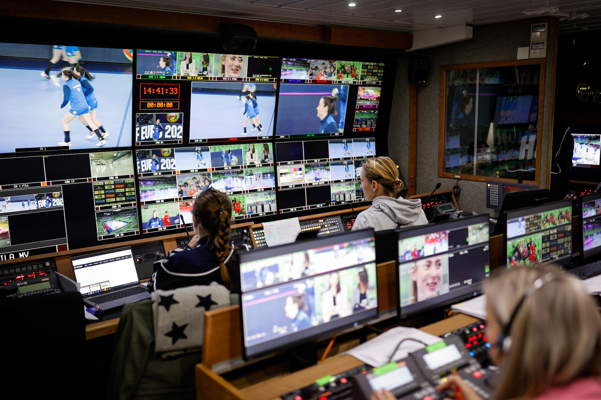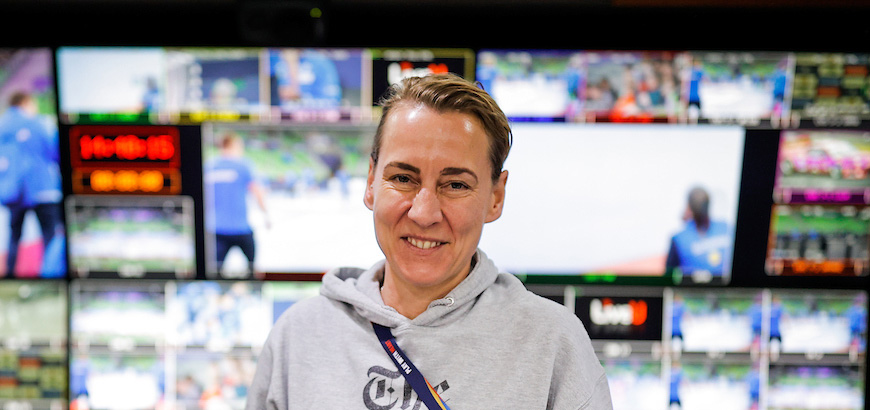When it comes to men’s and women’s handball, from a perspective of telling the story of the game, there is no difference. The only consideration is the size of the players, which can have a minor impact on some elements of the direction.
“I would not differentiate at all between men’s and women’s handball in terms of quality or speed or anything,” says Wanek, although she does find one different prior to the matches. “In men’s handball, they’re all like, super serious — mostly. The women, they are having a ton more fun. You see so many smiles and high fives and dancing to music and stuff like that when they start to warm up or before they come onto the court. I see more joy.”
Thinking of differences in men’s and women’s sport, the thought comes to mind of how athletes have often been presented in the media and by sports fans — it seems clear that some sports photographers, journalists and TV directors focus more on players they deem attractive than others or on trying to highlight features of the athletes’ bodies.
Has Wanek seen that change in her career on the side of TV, and is it something she has taken into account in terms of how the female players are filmed and presented?
“That is definitely something I pointed out to my camera operators as well,” says Wanek, discussing some different warm-up games teams might play or exercises they might do that would end up highlighting certain parts of their bodies if shown on TV, as well as particular moments during the matches.
“That is also something which slowly changes. Many directors don’t show that anymore because it is inappropriate,” says Wanek.

Although this might be a little more of a consideration with female players, especially for a female director aiming to ensure positive change in terms of how women are presented and valued, it must also be taken into account for men — some shots do not contribute to a respectful presentation of the match no matter the gender on camera. In some sports, it can be more problematic or requiring of more attention than at the EHF EURO 2022.
“That is something which is probably a certain awareness that is changing slowly,” says Wanek.
It is not only concerning the athletes where certain shots or focus on particular athletes because of the way they look can be an issue — that can also happen when it comes to the crowds at sporting events. This is problematic because it reinforces certain ideas of women and how they “should” look, as well as catering to a certain audience for sporting events, when the idea would ideally be to focus on athleticism and performance and nothing more.
“If you have crowd shots, or if you ask your camera operator to find people in a crowd, they usually pick the most perfect woman — many of them would pick the most beautiful woman they can find,” says Wanek, adding that FIFA have now included avoiding these kinds of choices in their production guidelines.
“90% of the times I am the only woman on the truck”
As Wanek speaks, I cannot help but think about how even the fact that she and I are aware of this topic shows what we have witnessed in our careers about how female athletes are presented and talked about. Surely that is one reason it has been so important that more women are coming into the field of sports media in any role, as we can then help to raise awareness.
Both of us have heard many offhand comments about female athletes in our careers and it would have been easy to let those comments go and by extension allow the presentation of female athletes to stay focused on some of the wrong things. As time goes by, all of us in the sports media field have become more aware of ensuring equality.
“It is obviously not something you are so aware of or brave enough to address when you hear it when you are like 16 or 20 or even 25 and just starting out in the business and especially if you are in such a male dominated business. It can become an everyday business and it kind of stings,” says Wanek, highlighting how so many women feel such comments as very hurtful.
“If nobody stands up to it, it is not going to change, if people can just keep behaving like that.
“It’s verbal violence. And I don’t want to work like that. I don’t want to work in the environment that supports that and that is why I am pretty much trying to address it whenever I encounter it and just be really vocal about it.
“For me it was a part of growing up, I guess: becoming more aware of language, fairness, equality.”
There is little gender diversity in the sports TV production field — hardly any female commentators across any sport, and very few in positions such as Wanek’s. Wanek does not believe women are not interested in those roles, but that girls and young women choosing their career path may not be aware this is even an option. After all, so many people are unaware of how sports TV production works in the first place, so how often are girls and young women seeing women in these roles and thinking “I could do that”?
“I think it’s for one reason, which is some sort of mantra: ‘You can’t be what you can’t see.’ If you don’t know that there are women in these roles, you would never, as a kid or girl, imagine yourself in a role,” says Wanek, who hopes things will continue to change rapidly and that in some years she will look back with a different view of her field.
For now, she looks ahead to bringing TV viewers a great show over the final weekend of the EHF EURO 2022.

 I would not differentiate at all between men’s and women’s handball in terms of quality or speed or anything. In men’s handball, they are all like, super serious — mostly. The women, they are having a ton more fun. You see so many smiles and high fives and dancing to music and stuff like that when they start to warm up or before they come onto the court. I see more joy.
I would not differentiate at all between men’s and women’s handball in terms of quality or speed or anything. In men’s handball, they are all like, super serious — mostly. The women, they are having a ton more fun. You see so many smiles and high fives and dancing to music and stuff like that when they start to warm up or before they come onto the court. I see more joy.







